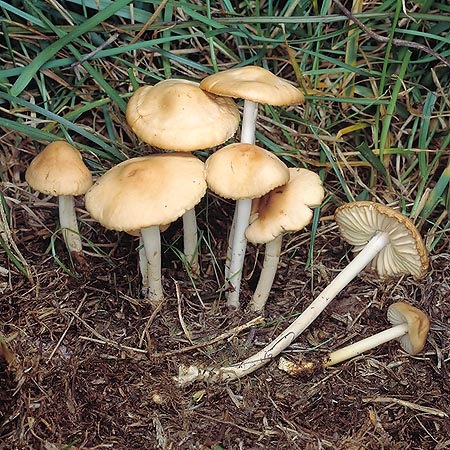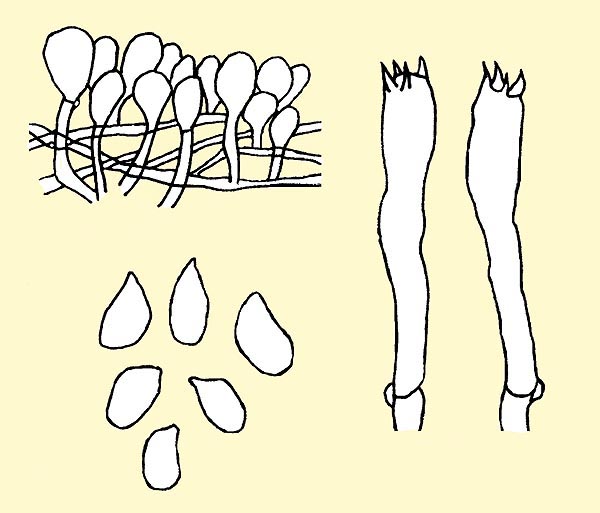
Text © Pierluigi Angeli

English translation by Mario Beltramini

Good edible, not to mistake with Marasmius collinus, toxic © Giuseppe Mazza
Family: Marasmiaceae Roze ex Kühner 1980.
Genus: Marasmius E.M. Fries 1835.
Marasmius oreades (Bolton) E.M. Fries (1836).
The name comes from the Latin “oreades” = woods nymphs, mountain nymphs.
Commonly known in Italy as “gambe secche”, due to its thin, tough and coriaceous stem.
Description of the genus
To the genus Marasmius do belong species of small or medium size which have the characteristic, when dry, to revive after the rain, and for this reason they are defined “reviviscent”.
The carpophores are little fleshy, membranous, with cap from smooth to striate-pleated; the gills are adnate, sinuate, free or with collarium, averagely spaced, usually thick; the stem is thin, cylindroid and filiform, firm, of corneous consistency. The flesh is exiguous, often with garlicky smell and taste. They are either lignicolous, terricolous, or humicolous fungi. The spores are white in mass, non amyloid, smooth, from obovoid to larmiform.
Description of the species
Cap: 2-5 cm, initially hemispherical, then campanulate-convex, finally applanate, with obtuse and broad umbo; undulate, smooth, crenulated at times, thin margin; smooth, hygrophanous cuticle, of greasy-brilliant look, orange-ochraceous or brownish with wet weather, yellow, more or less creamy with the dry one.
Gills: well spaced, broad, ventricose, not joined to the stem, intercalated by several whitish or creamy lamellulas of various lengths.
Stem: 3-7 x 0,4-0,6 cm, cylindroid, often widened upward by the base of the cap and at times also downward at the base, tough, elastic, rigid, fleshy; finely velutinous, powdery, finally smooth, of a creamy colour, brownish at the base, with white felting.

Marasmius oreades spores, pileipellis and basidia © Pierluigi Angeli
Flesh: very thin, exiguous, elastic, hygrophanous, coriaceous in the stem, whitish; pleasant aromatic smell, sweet tasting.
Habitat: it grows from spring to autumn, in much numerous families, in rows or fairy rings, in the lawns among grasses.
Edibility: edible, very sought for, only the cap being utilized, as the stem is coriaceous.
Spores: ellipsoidal, with seed or drop-like shape, guttulate, smooth, 7-11 × 4-6 µm. White spores in mass.
Basidia: clavate, tetrasporic, with joint buckles, 39-47 × 6,5-8 µm.
Pileipellis: formed by more or less clavate, piriform, the underlying hyphae are irregularly entangled, septate and joint buckles.
Remarks. It is a fungus which can be dried up, revived, and dried up again without any putrefaction, for this reason, it is defined as reviviscent. It grows in abundance in the classic “fairy rings”, is very much sought for and appreciated.
It can be mistaken with the Marasmius collinus (Scopoli: E.M. Fries) Singer, which is much similar and grows up in the same habitats; it differs for the glabrous stem, almost immediately hollow, frail, for the thicker gills, for the flesh which emanates a not very pleasant smell, like of Scleroderma, and for the closer spores. Marasmius collinus is to be considered as not edible; it seems to be indigestible and to be the cause of slight intoxications.
Synonyms: Agaricus coriaceus Lightfoot (1777); Agaricus oreades Bolton (1792); Agaricus pratensis Hudson (1778); Agaricus pseudomouceron Bulliard (1812); Collybia oreades (Bolton) P. Kummer (1871); Scorteus oreades (Bolton) Earle (1909).
→ For general notions about Fungi please click here.
→ To appreciate the biodiversity of MUSHROOMS please click here.
